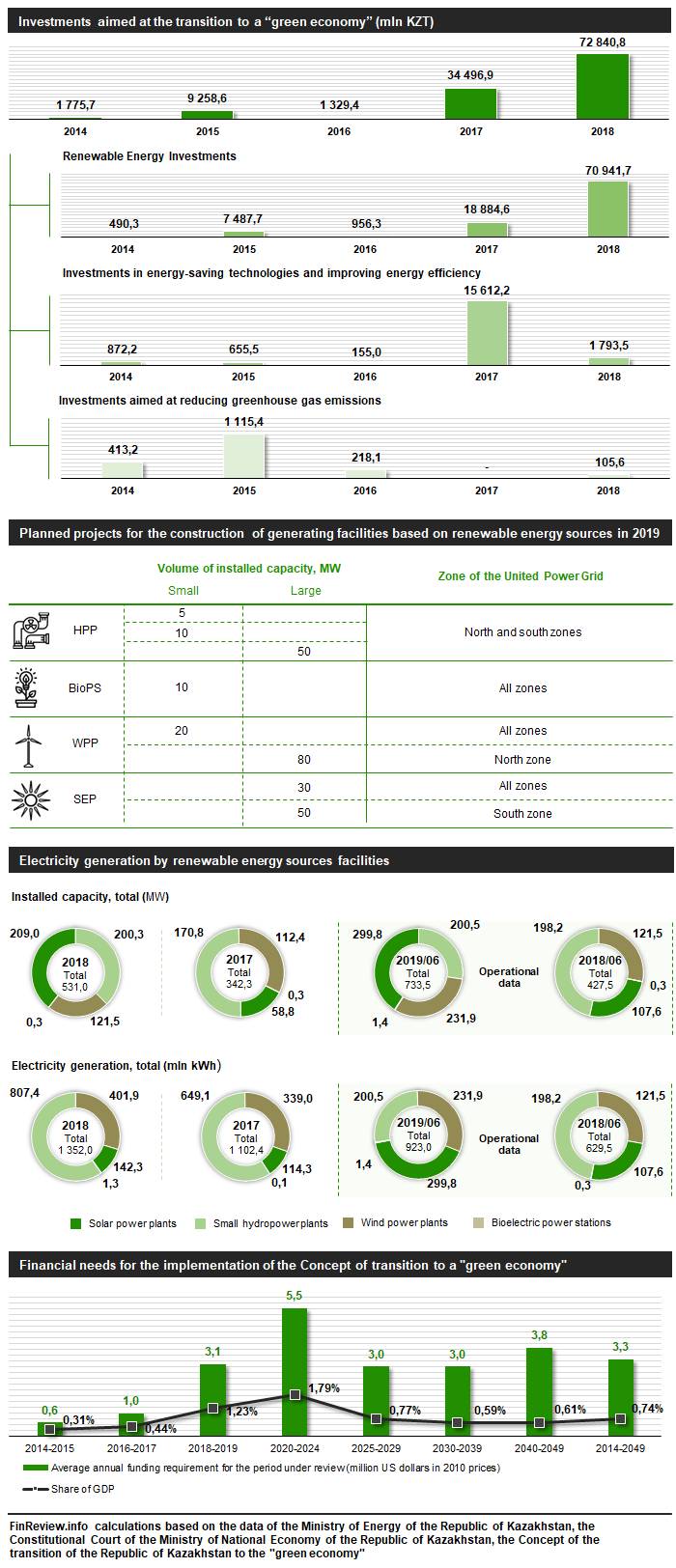Kazakhstan has the necessary potential for the use of renewable energy sources (RES), but their share in electricity production is only 1.3%. In developed countries, the figure reaches an average of 22%. The transition of Kazakhstan to the “green economy” will not only save the environment, but also reduce economic losses from the irrational use of natural resources. As a result, an additional GDP growth by 3% is expected.
Global energy demand increased by 2.3% in 2018 year, which is almost double the average growth rate since 2010 year. As a result, carbon dioxide emissions increased by 1.7% to a maximum of 33 gigatons. The largest increase accounts for natural gas, which became the preferred fuel, constituting almost 45% of the increase in total energy demand. The share of renewable energy sources was 26%. That is, the bulk of the produced energy is generated by burning organic fuels (oil, coal, gas, etc.). According to forecasts, the main sources of energy will be exhausted in about 40 – 100 years. In particular, oil reserves may end in 40-50 years, gas 80 years, uranium 80-100 years, and coal 300-300 years.
In Kazakhstan, according to the results of 2018 year, the share of coal in the structure of energy consumption was 55%, gas and oil – 20%, renewable energy sources (RES) – 1.3%.
According to the Concept of the transition of Kazakhstan to the “green economy” by 2050 year, it is planned to increase the share of alternative energy in the total amount of energy produced, up to 50% with an intermediate growth of 3% by 2020 year and 30% by 2030 year. The transition will be based on seven key areas:
- development of renewable energy sources;
- energy saving and energy efficiency;
- development of sustainable and efficient organic agriculture;
- waste management;
- rational use of water resources;
- development of “green transport”;
- conservation and effective management of ecosystems.
The transition to a “green economy” provides not only the careful use of natural resources and environmental protection, it also outlines the integrated importance of balanced and full-scale growth as an effective solution to achieve the goals of sustainable development.
It is expected that the introduction of green technologies will lead to an increase in the energy efficiency of the Kazakh economy by 40-60%, as well as to a reduction in water consumption by 50%. Moreover, the transition to a green growth model will allow for additional GDP growth of 3%, create more than 500 thousand new workplaces, create new industries and services, universally ensure high standards of quality of life for the population.
The total investment required to implement the Concept is estimated at an average of 3-4 billion US dollars per year. The maximum annual investment will be required from 2020 to 2024 years in the amount of 1.8% of total GDP. At the same time, the bulk of investments will be attracted from private investors.
According to the results of 2018 year, 72.8 billion tenge of investments were allocated for the development of the “green economy”, which amounts 0.12% of GDP. Almost all funds, or 70.9 billion tenge, were directed to renewable energy sources. The remaining funds, namely 1.8 billion tenge, were invested in energy-saving technologies and 105.6 million tenge – to reduce greenhouse gas emissions.
Kazakhstan is the only country in Central Asia that has both solar and wind generating capacities, which is a driver for further development of renewable energy sources. The hydropower potential of medium and large rivers is 55 billion kWh, and of small rivers – 7.6 billion kWh per year. The potential of solar and wind energy is estimated at about 2.5 billion and 1.82 billion kWh per year, respectively. That is, the total potential of renewable energy is 1885 billion kWh per year, which is equivalent to a capacity of 4.3 GW.
In Kazakhstan, there are 75 RES facilities, among which the SPP Saran (100 MW), the SPP Burnoye Solar 1 (50 MW), the SPP Burnoye Solar 2 (50 MW), and the First WPP (45 MW) are the most powerful.
The relevance of the transition to a “green economy” is determined by both economic costs and a significant deterioration in the state of natural resources and the environment. Thus, according to experts, the inefficient use of resources leads to a lost profit for the economy of 4-8 billion US dollars per year, and by 2030 year it may increase to 14 billion US dollars. At the same time, the potential for energy savings is $ 3-4 billion, and by 2030 year it can reach $ 6-10 billion.
Economic losses incurred as a result of low productivity of lands range from $1.5 billion to $4 billion. The consequence of these losses may be socio-economic tension in the agricultural sector, where 30–45% of the population is employed in such areas as North Kazakhstan, Almaty, South Kazakhstan.

Despite the ongoing diversification policy, the economy of Kazakhstan remains committed to raw materials – the volume of GDP by 31% was generated by industrial production and 17% by means of the mining sector. The consequence of this is the strong dependence of the economy on the volatility of energy resources prices. In 2018 year, the volume of oil production amounted to 77.5 million tons (an increase of 6.3%), which in monetary terms corresponds to 11.8 trillion tenge. However, external economic factors affecting oil pricing pose risks to the sustainability of the development of the national economy. According to the forecasts of the International Energy Agency and the US Energy Information Agency, until 2035 year, the expected cost of a barrel of oil will be in the range of 50 to 200 US dollars.
In this regard, the development of new industries and the transition to the principles of the “green economy” are becoming a backbone element, which can reduce the concentration of the national economy and the imbalance in the development of regions, which subsequently will effectively affect the development of economic sectors.
The transition of Kazakhstan to the “green economy” is impossible without updating and developing new infrastructure, otherwise in the near future the country will face the problem of the incompetence and uncompetitiveness of its mechanisms. In this regard, by 2030 it is planned to erect 55% of buildings and 40% of power plants, as well as updating more than 80% of the fleet. At the same time, by 2020 year, it is expected that the energy intensity of GDP will decrease by 25% compared to the initial level of 2008 year.
The current energy intensity of Kazakhstan’s industry is 4-5 times higher than in European countries. The energy intensity index of the country’s GDP in the world ranking is 1.9, while in Japan – 0.1, and in Germany – 0.16. In this regard, among the priority sectors of economic development are energy efficiency, the construction market and the development of RES.
The cost of renewable energy sources is almost 3 times higher than the cost of traditional sources. High tariffs are associated with the need to attract borrowed funds for the implementation of projects whose interest rates exceed 10%. Given that the payback of renewable energy facilities is achieved within 10-15 years, borrowed financing is very expensive. The solution to this problem may be the issue of “green” bonds, which are actively used in world practice. In 2018 year, $167 billion was attracted to international green projects (in 2017 year, $158 billion). According to forecasts in 2019 year, the volume of issued bonds is expected to reach $ 200 billion. The largest issuers are the USA (21%), Belgium (19%) and China (8%).
Kazakhstan is expected to issue green bonds on the basis of stock exchange of the Astana International Financial Centre – Astana International Exchange (AIX) . Following the acquisition of a solar battery business from NAC Kazatomprom JSC, the KazPV Consortium intends to attract financing through the AIX stock exchange.
The Government of Kazakhstan provides renewable energy producers with preferential fixed tariffs and other forms of state support. Preferential fixed tariffs are set for a period of 15 years, taking into account the annual inflation indexation. Moreover, for the development of the renewable energy sector, the Government will reimburse 50% of the investments for the installation of renewable energy source stations (more than 5 kW) for households and enterprises that do not have access to a centralized electric grid.

